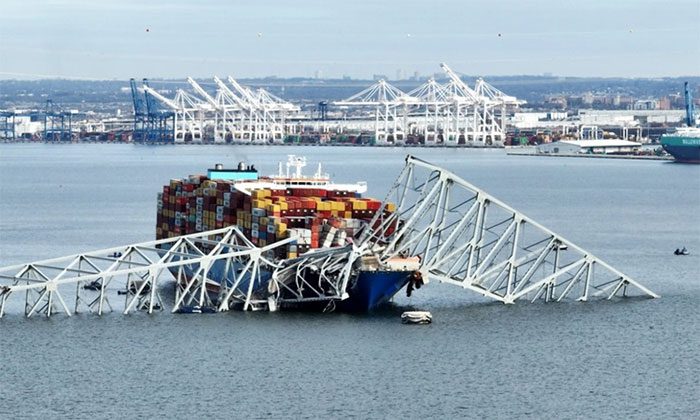The design of the Francis Scott Key Bridge from the 1970s may not be robust enough to withstand strong impacts from large container ships.
Footage of the cargo ship crashing into the Francis Scott Key Bridge in Baltimore, Maryland, USA, early on March 26. (Video: X/HaywerdJablomi)
A massive cargo ship collided with the Francis Scott Key Bridge in Baltimore, Maryland on March 26, leading to several people being reported missing and significantly impacting the local economy. Many questions have arisen regarding the incident, including why the ship struck the bridge directly and why the bridge collapsed so rapidly following the collision, according to the Independent. Experts suggest it may be too early to determine exactly what happened during the collision and subsequent collapse. However, they emphasize that bridges of this type need to be built with protective measures to withstand such impacts, as it would require an enormous force to cause a bridge to collapse.
Historically, many bridges have collapsed due to collisions with vessels. From 1960 to 2015, there were 35 major bridge collapses following collisions with ships, according to researcher Toby Mottram from the University of Warwick. This existing risk has driven the construction of modern bridges with collision resistance. Engineers have developed a range of safety requirements and solutions to ensure the integrity of bridges in the event of a collision.
(Video: AFP).
Large bridges spanning shipping routes require protective measures for their piers and supports. These protective measures can take various forms, according to Robert Benaim, a bridge designer and research fellow at the Royal Academy of Engineering. “They can include structural protection such as installing steel structures on the seabed to prevent or redirect ships. Additionally, artificial islands can be utilized for larger vessels, preventing them from coming close to the bridge piers,” Benaim explained.
The Francis Scott Key Bridge is relatively modern, leading experts to believe that it was designed with the expectation that its piers would be capable of withstanding collisions. The integrity of the bridge’s piers is crucial because any structural damage in that area, especially at the center, can lead to the entire bridge collapsing. According to Lee Cunningham, an associate professor and structural engineering expert at the University of Manchester, the mass and speed of a ship are key factors that determine the impact force. Similarly, the angle of impact is also an important factor, calculated based on the ship’s path.
In the case of the Francis Scott Key Bridge, the design from the 1970s may not have accounted for the massive size and strength of the vessels operating below today. The cargo ship that struck the bridge, named Dali, is enormous, measuring 300 meters in length and 48.2 meters in width, carrying a large cargo at an undetermined speed. According to Professor Mottram, it is conceivable that the bridge’s piers were not designed to withstand the scale of collisions from modern ships, as vessels like Dali did not operate through Baltimore’s port during that era. While it met safety standards and design regulations in the 1970s, the Baltimore Key Bridge may not have been equipped with protective measures to cope with the movements of today’s ships.

The collapsed bridge and the container ship that caused the accident.
However, Professor Mottram also emphasized that it was not only the bridge’s technology that failed to prevent the collision disaster. “The navigational technology should have been able to prevent the ship from crashing directly into the bridge,” he stated. According to Mottram, the investigation should prioritize clarifying why this technology did not function on the ship.
The footage of the collision reveals a striking aspect: the bridge collapsed far too quickly. As soon as the bridge began to sag, it rapidly fell entirely. This is partly due to the structure being built as a continuous girder bridge, made from a long steel girder spanning three main spans, rather than multiple segments joined together at the bridge’s piers.
Collisions with large vessels like the cargo ship Dali far exceed the design load for the elongated concrete piers that support the girder structure. Once the bridge pier was destroyed, the entire girder structure would collapse extremely quickly, explained Andrew Barr, a research fellow in the Department of Structural Engineering and Civil Engineering at the University of Sheffield.
“This is an example of a process that engineers refer to as progressive collapse, where damage in one structural component leads to damage in an adjacent component, resulting in an inability to support the new load above. In this case, the collapse of the pier caused the girder to sag without support above and fall. Since this is a continuous girder, the load is redistributed. The section of the girder around the remaining pier acts like a seesaw, temporarily lifting the span to the north before the tension causes it to collapse as well. As a result, the entire girder section fell into the water,” Barr shared.
|
The cargo ship struck the girder of the Francis Scott Key Bridge in Baltimore, Maryland, causing spans of the bridge to collapse and numerous vehicles to fall into the river. Social media footage shows the large cargo ship crashing into the Francis Scott Key Bridge around 1:30 AM on March 26, causing the spans to successively fall into the Patapsco River. At least 20 people and numerous vehicles fell into the river. The ship also caught fire following the collision. Authorities reported that the vessel involved in the incident is named Dali. According to data from the ship tracking website MarineTraffic, Dali is a container ship registered in Singapore, en route from Baltimore port to Colombo, Sri Lanka. The Francis Scott Key Bridge is a steel bridge spanning the Patapsco River, a vital transportation artery connecting to the Baltimore port, facilitating cargo transportation by water along the East Coast of the United States. The bridge was inaugurated in 1977, features four lanes, spans 2.5 kilometers, and is named after the author of the U.S. national anthem. |




















































